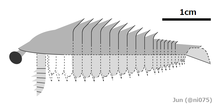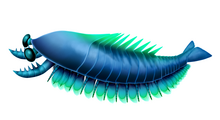
Lobopodians are members of the informal group Lobopodia, or the formally erected phylum Lobopoda Cavalier-Smith (1998). They are panarthropods with stubby legs called lobopods, a term which may also be used as a common name of this group as well. While the definition of lobopodians may differ between literatures, it usually refers to a group of soft-bodied, marine worm-like fossil panarthropods such as Aysheaia and Hallucigenia.

Anomalocaris is an extinct genus of radiodont, an order of early-diverging stem-group arthropods.

Amplectobelua is an extinct genus of late Early Cambrian amplectobeluid radiodont, a group of stem arthropods that mostly lived as free-swimming predators during the first half of the Paleozoic Era.

Chuandianella ovata is an extinct bivalved arthropod that lived during Cambrian Stage 3 of the Early Cambrian. It is the only species classified under the genus Chuandianella. Its fossils were recovered from the Chengjiang Biota in Yunnan, China.

Ercaicunia is genus of bivalved Cambrian arthropod from the Chengjiang biota of Yunnan, China. It contains a single species, E. multinodosa that was described by Luo et al. in 1999. The total length of the body ranges from 8 to 11 millimetres. The bivalved carapace covered about a third of the total body-length, and has up to six serrations on its forward edge. The head has a pair of large uniramous antennae, as well as a smaller pair of secondary antennae, as well as pair of mandibles and maxillae. The trunk has 16 pairs of biramous appendages. Specimens were CT scanned in 2019, which suggested it to be a stem-group crustacean. Other subsequent studies have recovered it as a member of Hymenocarina, which contains other bivalved Cambrian arthropods.

Haikoucaris is a genus of megacheiran arthropod that contains the single species Haikoucaris ercaiensis. It was discovered in the Cambrian Chengjiang biota of China.
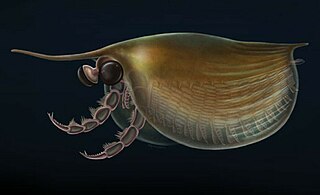
Isoxys is a genus of extinct bivalved Cambrian arthropod; the various species of which are thought to have been freely swimming predators. It had a pair of large spherical eyes, and two large frontal appendages used to grasp prey.

Kunmingella is genus of Cambrian bradoriid from the Chengjiang biota, containing the single species K. douvillei. Kunmingella had 12 appendages, including a pair of antennae as well pairs of biramous limbs, including four anterior pairs of appendages bearing double rows of endites on their endopods, and a posterior 5 with only a single row of endites, as well as two terminal pairs of uniramous limbs. Eggs have been found preserved attached to the posteriormost three pairs of biramous limbs, suggesting it engaged in brood care. Around 50–80 eggs, each around 150–180 μm across were attached in total.

Pectocaris is a extinct genus of bivalved arthropods from the Cambrian Maotianshan Shales, Yunnan Province of China. There are currently three known species within the genus.

Pygmaclypeatus is a genus of trilobite-like arthropod from the Cambrian aged Chengjiang biota of southern China. The carapace is flat and broad, and slightly shorter than it is wide, reaching a maximum width of 17.5 millimetres (0.69 in) and length of 14 millimetres (0.55 in). The headshield makes up about 25% of the total length, and has attached a pair of antennae, as well as four pairs of biramous limbs. The trunk has 6 tergites, each associated with a pair of biramous limbs along with a terminal pygidium associated with four pairs of biramous appendages and a segmented short tailspine. The well developed paddle-like exopodites on the trunk and pygidium limbs along with its small size suggests that it was an effective swimmer with a strong power stroke, and that it probably had a nektobenthic mode of life, swimming close to the ocean floor. Given its delicate spinose endites on the limbs it likely only consumed soft food and organic particles. It is considered to be closely related to Retifacies from the same deposit with shared characters including a segmented tailspine. It has been placed as a member of Artiopoda, possibly along with Retifacies the earliest diverging lineage of the Trilobitomorpha.

Radiodonta is an extinct order of stem-group arthropods that was successful worldwide during the Cambrian period. They may be referred to as radiodonts, radiodontans, radiodontids, anomalocarids, or anomalocaridids, although the last two originally refer to the family Anomalocarididae, which previously included all species of this order but is now restricted to only a few species. Radiodonts are distinguished by their distinctive frontal appendages, which are morphologically diverse and used for a variety of functions. Radiodonts included the earliest large predators known, but they also included sediment sifters and filter feeders. Some of the most famous species of radiodonts are the Cambrian taxa Anomalocaris canadensis, Hurdia victoria, Peytoia nathorsti, Titanokorys gainessii, Cambroraster falcatus and Amplectobelua symbrachiata, the Ordovician Aegirocassis benmoulai and the Devonian Schinderhannes bartelsi.

Kiisortoqia soperi is an extinct species of arthropod from the Early Cambrian Sirius Passet Lagerstätte in Greenland. While it had a superficially trilobite-like bodyform, it also possessed large frontal appendages similar to those of radiodonts.

Squamacula is an extinct artiopodan arthropod from the Cambrian Series 2. The type species S. clypeata was described in 1997 from the Chengjiang biota of Yunnan, China. At the time of description there were only two known specimens of S. clypeata, but now there are at least six known specimens. In 2012 a second species S. buckorum was described from the Emu Bay Shale of Australia.
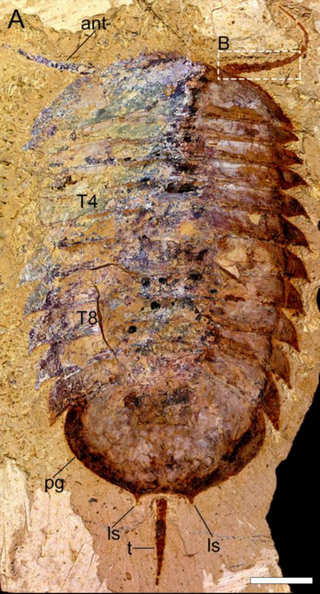
Retifacies abnormalis is an extinct arthropod that lived in the lower Cambrian. Its fossil remains have been found in the Maotianshan Shales of Yunnan, China. It is a member of the Artiopoda, and closely related to Pygmaclypeatus.

Kylinxia is a genus of extinct arthropod described in 2020. It was described from six specimens discovered in Yu'anshan Formation in southern China. The specimens are assigned to one species Kylinxia zhangi. Dated to 518 million years, the fossils falls under the Cambrian period. Announcing the discovery on 4 November 2020 at a press conference, Zeng Han of the Nanjing Institute of Geology and Paleontology, said that the animal "bridges the evolutionary gap from Anomalocaris to true arthropods and forms a key ‘missing link’ in the origin of arthropods," which was "predicted by Darwin’s evolutionary theory." The same day the formal description was published in Nature.
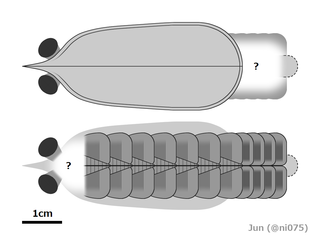
Erratus is an extinct genus of marine arthropod from the Cambrian of China. Its type and only species is Erratus sperare. Erratus is likely one of the most basal known arthropods, and its discovery has helped scientists understand the early evolution of arthropod trunk appendages. Some of the stem-arthropods like radiodonts did not have legs, instead they had flap like appendages that helped them swim. Erratus on the other hand had not only flaps but also a set of primitive legs. It also supported the theory that the gills of aquatic arthropods probably evolved into the wings and lungs of terrestrial arthropods later in the Paleozoic.

Jugatacaris is an extinct genus of bivalved arthropod known from a single species, Jugatacaris agilis found in the Cambrian Stage 3 aged Chengjiang biota of Yunnan, China. The carapace is around 28 to 37 millimetres in length, with a pronounced ridge at the top of the carapace separating the two valves, which formed a fin-like structure raised above the carapace. The head has a pair of stalked eyes, as well as a dumbbell shaped medial eye between them. The head also bore a pair of mandibles as well as at least one and possibly two pairs of antennules. The trunk had up to 65 segments, each with biramous appendages. The appendages had thin endopods with 30 podomeres, each bearing a spiny endite, with the endopods ending with a terminal claw. The appendages also had overlapping flap-like exopods, which are elongated, being at maximum eight times as long as they are wide, which on their posterior edge are covered with setae. The trunk ended with a forked tail. It was likely an actively swimming filter feeder, using its constantly beating appendages to sift food from the water column, which was then passed forward along the U-shaped food groove between the appendage pairs towards the mouth. While initially placed as a crustaceanomorph, later studies considered to be a member of Hymenocarina, which contains numerous other similar bivalved Cambrian arthropods.

Fortiforceps is an extinct genus of Cambrian megacheiran arthropod known from the Chengjiang biota of Yunnan, China. It was originally described by Hou and Bergström in 1997, and redescribed in 2020. It was relatively small, at 4 centimetres (1.6 in) or less in length. The head had a large pair of stalked eyes, a pair of frontal projections, as well as a pair of great appendages, like other megacheirans, along with two other cephalic appendages. The trunk had either 20 or 22 segments, depending on the specimen. These segments had pronounced blade-like spines on their upper-outer edge. Each of the trunk segments were associated with pairs of biramous limbs, which probably have seven podomeres and like other megacheirans, have paddle-shaped exopods. The trunk terminated with a forked tailpiece, which on their outer edges had rod-like structures. The two lobes were separated by a rectangular central piece. It has been placed as a member of the family Jiangfengiidae, alongside Jianfengia, Sklerolibyon and possibly Parapeytoia.

Oestokerkus is an extinct genus of Cambrian megacheiran arthropod known from the Emu Bay Shale of Kangaroo Island, Australia. It belongs to the family Leanchoiliidae. It had a large head shield that was more than a third of the trunk's length, as well as a large pair of eyes. The great appendages have long flagellae projecting from them. The head shield probably had two pairs of cephalic appendages. The trunk has 11 segments. The exopods of the biramous limbs are fringed with long setae. The body ended with a telson, which was probably dorsally flattened.

Isoxyids are members of the order Isoxyida and the family Isoxyidae, a group of basal arthropods that existed during the Cambrian period.
